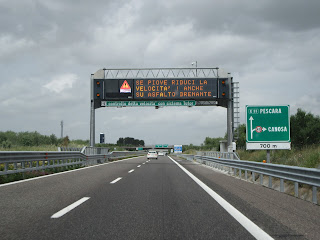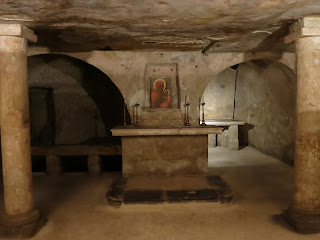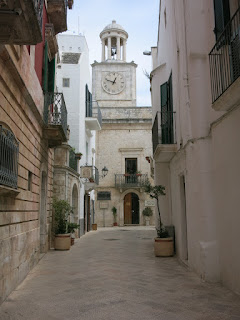 We started out with my 're-discovery' of history. Yes, I have known of my ancestry via DNA testing and chasing my family history back for some generations. USA, World War II and the atomic bomb, Civil War, Irish immigrants, Revolutionary War – all were familiar to me. But, recently I came to understand my background had elements of Roman, Anglo-Saxon, Norman, French, Iberian, and Viking heritage. This trip to Prague and southern Italy allowed me to explore additional historical perspectives of Greek, Roman, Bohemian, and European civilizations and weave them into the puzzle that we call 'History'.
We started out with my 're-discovery' of history. Yes, I have known of my ancestry via DNA testing and chasing my family history back for some generations. USA, World War II and the atomic bomb, Civil War, Irish immigrants, Revolutionary War – all were familiar to me. But, recently I came to understand my background had elements of Roman, Anglo-Saxon, Norman, French, Iberian, and Viking heritage. This trip to Prague and southern Italy allowed me to explore additional historical perspectives of Greek, Roman, Bohemian, and European civilizations and weave them into the puzzle that we call 'History'.
Well, Tom and I are on our way home and writing this from about 35,000 feet halfway over the Atlantic. Both of us have had a most memorable celebratory trip over the past three (3) weeks. This will be our last post of the blog for this trip – it will be a great remembrance and catalog of our experiences and something that we will enjoy reviewing over the years to come. Tom and I hope you have enjoyed reading and experiencing this journey through our minds, eyes, and photographs.
Tom and I saw so much every day that translates into who are today and makes us realize that we are just a small piece of the 'GRAND DESIGN' when viewed in the lens of all the years of history that have proceeded us. Our days were indeed complete having done and seen the things we set out to accomplish – and then I had to write the blog – which most nights took me almost to 12 midnight. But, that's OK as I wanted to record and share every aspect of our journey and exploration.
So, with that as the backdrop, let me offer my final comments and observations . . . from Prague and Kutna Hora in the Czech Republic, to Rome, to Pompeii, to Sorrento and the Amalfi Coast, to Minori, to Paestum, to Eboli, to Matera, to Lecce, to Ostuni, and to Monopoli . . . it was a fantastic trip with Tom.
The pictures you see on this post are ones that 'didn't make the cut' on our previous posts – but, we think they deserve a place here – not in any order, but just because they are reflective of our trip to Prague and Southern Italy.
This morning we woke in Rome before dawn at 4:30 AM (which makes it 10:30 PM on Thursday for you East Coasters and 7:30 PM for you West Coasters) – still dark and before the roosters got up ! Quick re-pack of our suitcases and change into our travel clothes and we were ready to head to the airport before Rome was even awakening.
We had already checked out of our hotel the previous evening as we knew the front desk would be closed, so it was just a matter of packing the car and heading off to the airport. Our offline GPS (aka Sophia) decided to 'sleep in' this morning so were relegated to finding the airport via old style road signs. Fortunately, we made it to Leonardo Da Vinci Airport in Rome without too many wrong turns and were on our way back to South Carolina via Madrid and Charlotte.
As to my impressions of Prague vs. Vienna – because both were seats of the Holy Roman Empire, I find the following of significance :
• They are both stunningly beautiful cities !
• The old, historical buildings of Vienna seem to mostly be confined to the “Old Town” section, where the seat of government was located, as opposed to Prague, which has an “Old Town” in addition to its castle on the hill, outside of the city walls.
• They are both stunningly beautiful cities !
• The old, historical buildings of Vienna seem to mostly be confined to the “Old Town” section, where the seat of government was located, as opposed to Prague, which has an “Old Town” in addition to its castle on the hill, outside of the city walls.
• There was much more damage done to Vienna than Prague during World War II – Vienna was bombed, while Prague was occupied.
• The people of Prague are still recovering from their years under Communist rule.
• It was much easier for us to deal with the German language in Vienna, than the Czech language in Prague.
• The people of Prague are still recovering from their years under Communist rule.
• It was much easier for us to deal with the German language in Vienna, than the Czech language in Prague.
• Both cities have elaborate Cathedrals and churches. The population in Vienna regularly attend services, and the people in Prague are somewhat indifferent.
• Both cities have efficient subway, train, and bus systems.
• It was easy to tell who are the tourists – they are the only ones who wear khaki pants.
• Everyone that we spoke to who has been to America, has only been to New York City.
• Italy has so many unique places that we had never heard of, but we are so glad that we had the opportunity to visit.
• Both cities have efficient subway, train, and bus systems.
FINAL THOUGHTS
• I don't want to live in a castle – too cold !
• I don't want to live in a tiny house – mostly we stayed in tiny apartments with tiny kitchens, tiny bathrooms, and tiny showers !
• The Super Markets in Prague and Italy were not so super. They were very small, with a very limited selection. Most people shop at bakeries, butcher and cheese shops, and vegetable stands just about every day.
• I don't want to live in a castle – too cold !
• I don't want to live in a tiny house – mostly we stayed in tiny apartments with tiny kitchens, tiny bathrooms, and tiny showers !
• The Super Markets in Prague and Italy were not so super. They were very small, with a very limited selection. Most people shop at bakeries, butcher and cheese shops, and vegetable stands just about every day.
• It was easy to tell who are the tourists – they are the only ones who wear khaki pants.
• Everyone that we spoke to who has been to America, has only been to New York City.
• Italy has so many unique places that we had never heard of, but we are so glad that we had the opportunity to visit.
Thanks for reading and taking part in my blog . . . travel is wonderful, but there is no place like home ! . . . and, now, Prague and Italy are in the rear view mirror !

































































